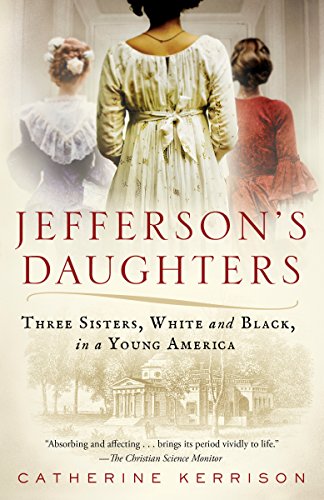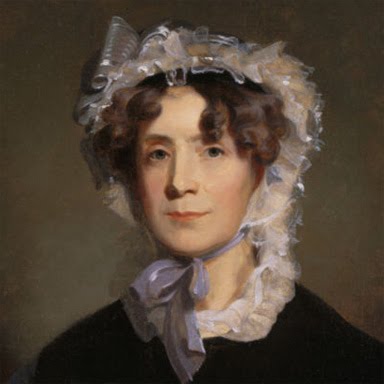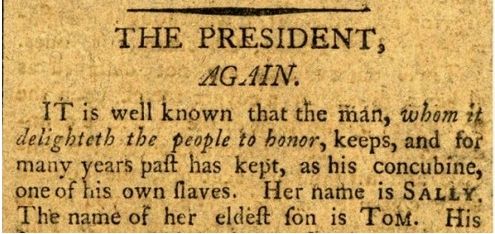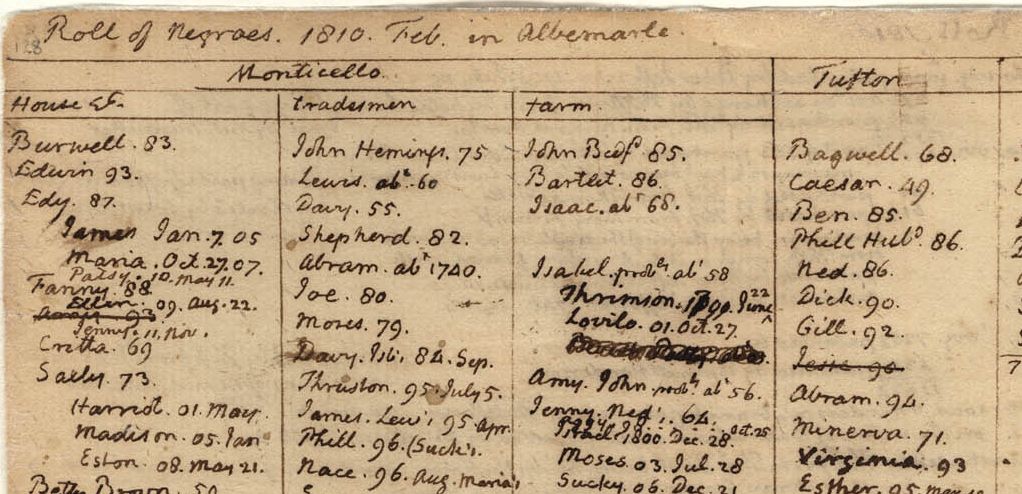Jefferson had children with his wife, Martha, and then with his and slave, Sally Hemings, and these children lived very different lives as a result of their race.
-
Fall 2019 - George Washington Prize Books
Volume64Issue5
Excerpted from the George Washington Book Prize finalist Jefferson's Daughters: Three Sisters, White and Black (Ballantine Books), by Catherine Kerrison.

Jefferson had been in Paris since 1784. After his wife's premature death, Congress had asked him to represent the United States at the peace table with Great Britain, and he grasped at the appointment as a drowning man would a rope. Escaping the painful memories etched into the very landscape of his home at Monticello, Jefferson crossed the ocean to France with his twelve-year-old daughter, Martha. Three years later, Martha's younger sister, Maria, joined them, accompanied by her slave, Sally Hemings.
By that fateful summer of 1789, Paris had changed them all. Famous for his role in drafting the American Declaration of Independence, Jefferson was sought after by French revolutionary moderates who persuaded him to host meetings as they hammered out their ideas to reform their government. But Paris was also the place where he had adopted the aristocratic wigs and elegant silk suits made fashionable by the French, and where he had fallen in love with their art, architecture, furniture, and books.
Like her father, Martha took an eager interest in the political ferment. Sporting a revolutionary cockade, she was the envy of her friends when General Lafayette, riding through the streets of Paris, recognized her with a chivalrous doff of his hat. Even little Maria was changed. Initially left behind in Virginia, she had not wanted to go to Paris when Jefferson wrotc to have her join him. But once arrived, the nine-year-old became so acclimated to the beauties of Paris that she broke down in tears on their return to Virginia as she surveyed the burnt-out ruins of Norfolk, their port of arrival. Sally Hemings had learned how to care for Jefferson's silk suits and linens, as well as the fashionable clothing of his daughters. She also learned French. By this pivotal moment in French (and Jefferson family) history, then, she had learned marketable skills and had seen the possibility of a way of life that was different from the slavery she had known in Virginia.
See also, "Did Sally Hemings And Thomas Jefferson Love Each Other?"
by Annette Gordon-Reed. American Heritage Fall 2008
In the fall of 1789, however, she would agree to join Jefferson and his daughters as they boarded the Clermont, bound for Virginia. But what kind of nation awaited them? As the newly elected president, George Washington, assembled his government, he faced the challenge of transforming the political system inscribed on paper in the Constitution into a working and workable government. Chief among the questions to be resolved was who, exactly, was included in the ringing phrase "We the People" with which that document opened. In this age of revolutions, the idea of independence did not only refer to a national government, free of monarchical tics. It also meant individual self-determination. But who was eligible to claim that right? More particularly, what changes might the American Revolution begin to effect, especially for women, free blacks, and slaves?

As the Jefferson party sailed home, they would have pondered these questions in very different ways. But Paris remained imprinted upon them all forever, shaping the courses of their lives and the choices they would make.
Two days before Christmas they arrived home at last. After a six-year absence, the master of Monticello returned to a joyous welcome. "The negroes discovered the approach of the carriage as soon as it reached Shadwell," Martha recalled at length, "and such a scene I never witnessed in my life. They collected in crowds around it, and almost drew it up the mountain by hand. The shouting, etc., had been sufficiently obstreperous before, but the moment it arrived at the top it reached the climax.
When the door of the carriage was opened, they received him in their arms and bore him to the house, crowding around and kissing his hands and feet –some blubbering and crying – others laughing." Such a homecoming for Jefferson, seventeen-year-old Martha, and eleven-year-old Maria was indelibly impressed in their memories. The story was told and retold, Martha remembered, embellished by later generations of slaves who swore that "the horses were actually 'unhitched,' and the vehicle drawn by the strong black arms up to ... the door at Monticello."
Somewhere in the scene that day – perhaps - was sixteen-year-old Sally Hemings, pregnant for the first time, with her master's child. It was a homecoming for her as well. She had been gone from Monticello as long as Jefferson had been. It was her childhood home, from which she had been called as a girl of nine or ten, a maid to a child. She returned a woman, committed to a lifetime relationship with Monticello's master. A new chapter was beginning for her and for the Hemings family: As Jefferson's "substitute for a wife" (in the phrase of one of his neighbors), Hemings was positioned to defeat the reach of slavery for her children and to ameliorate slavery's impact on her extended family.
But while the records reverberate with the exuberant celebration of the white family's return, they are utterly silent about Sally's. She may have arrived earlier with her brother James, if he had gone on ahead from Richmond. James was with Jefferson as late as December 10, when Jefferson gave him money to pay for their laundry, but there are no further notations in Jefferson's account book for the rest of the trip to track James's whereabouts. It is impossible to know.
The silence of the record is typical of white disregard for the significance of slaves' lives; it is striking how infrequently slaveholding families, particularly women, discussed the slaves on whom their daily lives depended. At the same time, the silence also underscores the deep significance of Sally Hemings in Thomas Jefferson's life as he returned to Monticello. As time would tell, Jefferson would arrange his life to accommodate the promises he made to her; he would refuse to acknowledge the accusations of his political enemies when they exposed his relationship with her; he never banished her from Monticello when it might have been easier for Martha and Maria if he did. His discretion protected his reputation as a Virginia gentleman, it is true; but it also provided some cover for Sally Hemings and her children. So effective was his silence, as Annette Gordon-Reed observed, it brought "down a curtain on his relations with Hemings and their children so heavy and thick that it took over a century and a half to effectively raise it."

Of course, both James and Sally Hemings returned to slavery. Although France's revolution was just beginning, the American Revolution was over, concluded with the Treaty of Paris in 1783. But the changes it had effected for enslaved Americans were severely limited. Jefferson's own attempt to condemn slavery in the Declaration of Independence had been deleted by the Continental Congress. Even though Jefferson had – inaccurately - framed slavery as a grievous evil imposed on the colonies by a corrupt monarchy, its condemnation in an American founding document could have had far-reaching implications. Instead the Constitution, just barely ratified by the time Jefferson got back from France, engraved in the country's legal framework a variety of protections for slavery, not least of which was a provision that forbade Congress from ending the slave trade for twenty years.
In Paris, as historian Annette Gordon-Reed remarked, Sally Hemings “learned that another type of life was possible.” Under the tutelage and guidance of her elder brother, James, she had experienced the sights and sounds of the city, mixing with other people of color to whom James introduced her. She had learned to speak French, watched the beginnings of revolution, and realized enough about French law regarding slavery to know that if she chose, she could remain in France, a free woman. She also had been inoculated against smallpox by the most prominent practitioner in Europe, spending six weeks away from Jefferson's household as she recuperated. She had mixed in elite Parisian society as a lady's maid, maybe attending Jefferson's daughters occasionally at their school but certainly present at the balls Martha frequented in her last months in Paris.
As we saw, the girls' schoolmates even included greetings to "Mademoiselle Sally" in their letters. Sally Hemings was a caste apart from other slaves, then, even before she entered into a relationship with Jefferson. Learning self-reliance at an early age, and living in a much wider world than was visible from Monticello, Sally Hemings was a mother of uncommon character and experience in the slave community. And in the new life she had negotiated for herself on her return from France, she occupied a new status: no longer a lady's maid to either Martha or Maria, off-limits to the governance of the overseer, and a mother of children destined for freedom.
The names of Sally Hemings's children are another indication of the special status this family occupied at Monticello. It was a common enough practice of slave owners to name their slaves, frequently bestowing names like Zeus, Apollo, and Hercules that contrasted cruelly with their subordinate status. But the names for Sally's children, drawn from Jefferson's family lines and circle of friends, were meaningful to him. Each had a story attached to it. Harriet's name came from a beloved Randolph, a younger sister of Martha's husband, Tom, who had sought relief from her young stepmother at the more congenial fireside of Monticello.
Jefferson and Sally Hemings used the name twice; Harriet was named for an elder sister, who had died in 1797 at two. William Beverley was likely named after a relative from Jefferson's mother's Randolph line, who in 1746 had traveled with Peter Jefferson on his first expedition to survey the far western reaches of Lord Fairfax's lands in Virginia. At the suggestion of Jefferson's family friend Dolley Madison, James Madison was named for Jefferson's closest friend and political associate, Thomas Eston for a favorite Randolph uncle. There had been no other Harriets in Jefferson's records before Sally's daughters; her sons' names are especially distinctive standouts in the Farm Book lists of slaves. And when we consider the names of Martha Jefferson Randolph's sons (James Madison, Benjamin Franklin, Meriwether Lewis, and George Wythe), the pattern, of all the boys' names (Hemings and Randolph), one historian noted, resembles "the act of a white man who has no white sons to name."

But as a very young child, Harriet would have been unaware of these nuances of status. She may have played with the Randolph girls on their occasional visits to Monticello. Two were particularly close to her in age: Virginia, born just three months after Harriet in August 1801, and Cornelia, born two years earlier. It was not at all unusual in the eighteenth and nineteenth centuries for very young children, free and enslaved, to spend their days playing together until they began to learn their respective conditions in life.
But, of course, Harriet Hemings was no Randolph and so could not enjoy their privileges. It is not likely that she was a recipient of Jefferson's largesse in her childhood. She would not have received the kinds of gifts Jefferson bestowed with such a generous hand on his granddaughters: a saddle and bridle, an elegant watch, a guitar, or silk dresses. But neither was Jefferson stern or cold to her. He was, Madison thought, "undemonstrative" by temperament, but at the same time "uniformly kind to all about him." But, he added, "he was not in the habit of showing partiality or fatherly affection to us Sally's children." So, it is not likely that he bestowed the gifts upon Sally Hemings's children that he did upon Martha's.
Nor did Jefferson follow the example of many planter-fathers in his own day who lived openly with their slave consorts, claimed the children of those unions, and provided for them. Bachelor fathers in New Orleans made a point of asserting paternity in baptismal records. Prominent white Floridians had large mulatto families, freed and educated their children, and provided for them in their wills, bestowing on them homes, land, and even slaves. In Jefferson's own state, there were multiple examples of fathers who freed their children with enslaved mothers, educated them, and bequeathed their own acreage to their progeny at their deaths. Of the several who also freed the mothers of their children, one even requested that he be buried beside her.
Against these fellow Virginians, Jefferson's provisions for Sally and her children were parsimonious by comparison, and always beneath the radar. On their return from Paris, he installed her with her sister Critta, in the stone structure he had built in the 1770s for his hired white builders. But, when he anticipated hiring white artisans for the remodeling project in 1793, he instructed Tom Randolph to move them out to the new houses he had built for them on Mulberry Row. Sally Hemings's house was built of wood, with a wood chimney and, by Jefferson's own description, "earth floors." There she raised their children until the south dependency was completed in 1808 and they were moved to a room there. Tucked under the terrace that afforded Jefferson and his family and guests a pleasant outdoor promenade from the house to the south pavilion, the south dependency contained the kitchen, cook's room, dairy, smokehouse, and washhouse - all functions necessary to the smooth functioning of Jefferson's household but, like the slave labor required to run them, hidden from the family's view.

